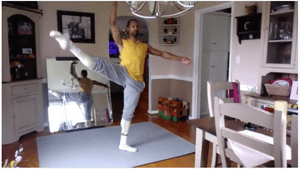Stay in the Loop
BSR publishes on a weekly schedule, with an email newsletter every Wednesday and Thursday morning. There’s no paywall, and subscribing is always free.
Jumping into life at home
How are leaders of the Pennsylvania Ballet weathering the pandemic?

When David Hoffman agreed to chair the board of directors of the Pennsylvania Ballet, ticket sales were lagging, as were contributions from donors. So he came on board with some conditions.
“I thought that the ballet was stagnating to a certain degree. I believed that we wanted to be the best ballet you could be as opposed to shrinking into something less,” says Hoffman, who began his current tenure during the 2014-15 season. He runs an investment company, but his father was a sculptor and his mother gave him his love of ballet, so the arts are in his DNA. “I saw Baryshnikov and Nureyev dance when I was a teenager,” he told me, which set a very high standard for what "the best ballet" could be.
At the PA Ballet, it took time to fulfill that promise. New artistic director Angel Corella (who came into his role in 2014) charmed donors with his ready smile and, after a rocky start, literally transformed the company, giving it a sharp, versatile style. Shelly Power came in as executive director in early 2018 and doubled the development staff. The contemporary ballet triple bills were slated to move to the Kimmel’s sleek Perelman Theater for the 2020-21 season.
But then, in the middle of the run of the opulent La Bayadère, Philadelphia theaters closed their doors. As COVID-19 rolled over the city, the company cancelled the rest of the season and, looking ahead, cancelled the 2020 Nutcracker as well. Now, Power says, they are in week-to-week discussions with the Kimmel Center. She hopes they can open in February 2021, but braces for another delay.
Raising money, raising hopes
For a dance company with a $15 million annual budget, fundraising is always a challenge, but with no programming, no ticket sales, and no gala events at which donors willingly succumb to the charm offensive, the company faces two challenges: raising money to survive the crisis, and staying in the public eye while it waits for theaters to open and audiences to return.
Power acknowledged the shock of the pandemic and the lost season, but said the donors stepped up: “We did an emergency relief fund to help us finish out the year, and we surpassed our goal.” Some staff, including half the development team, was laid off. Remaining staff took pay cuts to balance the budget for this year.
As Hoffman pointed out, it is less expensive to operate a company that is not performing, but it is not a winning strategy in the long run. The company stayed in the public eye with its Front Row Festival in June and July. The streaming series, offered free online and curated by Corella, let audiences revisit recent performances ranging from Juliano Nunes’s Connections to Corella’s vision of Petipa’s Don Quixote. But it wasn’t easy. The company had to acquire the rights from everyone involved—performers, choreographers, and designers—and for the music. “From the Balanchine Trust to Christopher Wheeldon to Jerome Robbins, everyone was really understanding,” Corella said. Most of the rights were given free, or for a nominal fee.
The festival drew between four and five thousand viewers and more than 15,000 visits. Corella expects it will be a greater challenge going forward, but the company is working on new ways to engage the dancers, perhaps with couples who already live and work together (the company has a lot of couples), and connect with its audience.
Jetés at home
For Corella, the wellbeing of the dancers comes first. After a short layoff, the company obtained a PPP loan to pay dancers through August. “They’re young people, young dancers, so I want to make sure that they are well taken care of personally. It is really hard for everyone, but especially for live performing artists. There is so much unknown. You have to keep everyone thinking positively.”

Some familiar dancers have moved on: Albert Gordon to the Hong Kong Ballet, and Alexandra Hughes and Aaron Anker to the Alberta Ballet. But the company has taken on new dancers Fernanda Oliviera and Isaac Hollis, and other dancers are moving up.
For the present, Corella is holding class via Zoom. Dancing at home has its disadvantages, though. It’s hard to practice grand jetés in the living room. Power described one dancer’s experience: “the people downstairs complained because they thought she was doing jumping jacks all day, and ‘oh, I’m so sorry,’ she said, ‘I’ve been doing my jumps every day to make sure I stay in shape.’”
Ballet perceptions
During the down time, the company is taking a deep dive into their branding as part of the long-term strategic plan. "It is a way to take a pause and evaluate where we are, how people know us, and how they perceive us,” Power said.
The company has a school again, opened in 2013, and Hoffman is particularly interested in the company’s community engagement, working with students and senior homes. Before the pandemic, they had hoped to expand their programs, which reached 17,000 people last year. Now they are looking for ways to take it online.
But mostly they want to broaden the audience’s perception of what the company actually does. “You hear ‘Pennsylvania Ballet,’ you think of one thing: tutus on the stage,” Hoffman said. He wants to draw Nutcracker fans in to see the contemporary pieces. “Dance is universal,” he said, but you want to be understood for what you are and not as the stereotype that people have in their mind.
Dance marches on
Corella has transformed the company with more full-length ballets (lots of tutus!) and contemporary choreography. He’s rebuilt the company on classically trained dancers who can adapt to new styles, so the messaging should reflect the company as it is now.
Power says they are not ready to jettison any of the old concepts that formed the Pennsylvania Ballet’s reputation. From where I sit in the audience, however, it is time to let the identity as a Balanchine company go. The company still honors the choreographer instrumental in its creation, but time and dance have moved on. To survive in a post-COVID world, the Pennsylvania Ballet must wholeheartedly embrace its new identity.
Sign up for our newsletter
All of the week's new articles, all in one place. Sign up for the free weekly BSR newsletters, and don't miss a conversation.

 Camille Bacon-Smith
Camille Bacon-Smith